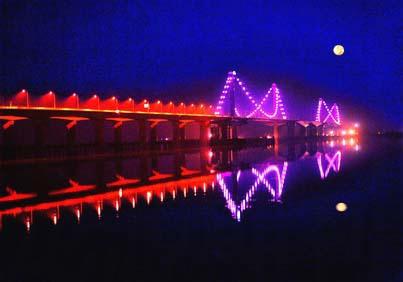Bridges Span Qiantang River
2009-05-31ZhangShengli
Zhang Shengli


The first emperor of the Qin Dynasty (221-206BC) came to the river more than 2,000 years ago. Sima Qian records in his great “Book of Historian” that the emperor reached the Qiantang River only to find the ferocious waves kept him from ferrying across, and that the emperor sailed westward upstream for 60 kilometers before he was able to cross the river from a narrow section. Where he crossed the river is where Hangzhou is today.
For thousands of years, the wide river did not have a bridge because of adverse circumstances such as treacherous quicksand and surging tides. It was not until 1937 that the first bridge, designed by Mao Yisheng, an outstanding bridge engineer of modern China, spanned the river just outside the city proper of Hangzhou. It was Chinas very first modern bridge designed and constructed by the Chinese. Shortly after the 1,072-meter-long railway-highway two-deck structure became operational, however, Japan invaded China in full blast and on December 23, 1937 Mao Yisheng was ordered to destroy the bridge with explosives. After World War II, the bridge was fixed. On March 1, 1947, the bridge was back to operation.
For about 50 years, the bridge played a key role in connecting the both sides of the river and in the regional economy. A survey in 1989 showed that the bridge witnessed a daily average traffic volume of 9,464 automobiles and 4,969 bikes. As modernization drive brought more changes to the city and the province, the river called for more bridges. Long before the 1989 survey, the city authorities had planned for a second bridge.
In 1986, a blueprint for a national railroad system was being prepared and the second bridge for the Qiantang River was seen as a key in this railroad system in eastern China. In October, 1986, decision makers met in Hangzhou to weigh all the possibilities and factors for the proposed bridge. Vice Premier Wan Li presided at the meeting. Decision makers and designers did the field study along the river. Their purpose to was to find a right place for a bridge that was to play a key role in the 21st century and would cater to a traffic volume of hundreds of millions of visitors a year coming to see the paradise city and the West Lake.
After thorough field studies, an ideal spot was chosen. It was 12 kilometers downstream from the first bridge, leaving a large space for the city to grow eastward in the future. The countrys best bridge engineers, best construction teams, and best building machinery convened on the river for the second bridge. It was the first bridge built in a spot where strong tides made bridge building almost impossible. This bridge still holds the world record for the longest reinforced concrete structure. And many new technologies that had never been used in China were first used in the construction.
Very soon, other bridges on the Qiantang River were on the drawing board. The third Qiantang River bridge was considered a must for further urban expansion and economic growth of Hangzhou. A few economic development zones had been built along the river and the Hangzhou Xiaoshan International Airport was about to be constructed while the traffic across the two bridges became increasingly heavier. Some traffic volume was diverted to the first bridge and auto ferries. Surveys and calculations showed that the volume grew at the rate of 24.8% per year and the airport would see eight million passengers a year.
The third bridge was a 600-million-yuan investment for the use of at least 50 years. In the second half of 1992, bridge experts from Shanghai-based Tongji University provided a raft of 30 designs for the bridge. The final winner is a cable-stayedstructure with two pylons. The bridge now spans the river between the first bridge and the second bridge.
Renaissance Bridge, the fourth, is located between the third and the first. It was completed in 2004, connecting the northern part of downtown Hangzhou with the Binjiang District on the south bank across the river.
The fifth bridge on the river is much upstream, at a spot where the Qiantang River, Fuchun River and Puyang River meet. The 3,126-meter-long bridge was operational at the year end of 2003. The curved bridge looks as if it were a part of an invisible circle whose radius is 1,100 meters.
The sixth bridge, called Xiasha Bridge, spans the river in the eastern part of Hangzhou, connecting the Xiasha Technology Park, a part of the Hangzhou Economic and Technological Development Zone. The 8,230-meter bridge provides access to various expressways. The six-lane structure is the longest, widest and tallest bridge on the river.
The construction of the seventh and the eighth bridges both kicked off on the same day in December 2008. The seventh bridge, called Zhijiang Bridge, is designed to divert heavy traffics from citys west and east to cross the river at the eastern edge of the Great Hangzhou. It is scheduled to be completed by the end of 2011. The eighth bridge is 2 kilometers downstream from the second bridge and another 8 kilometers downstream is the Xiasha Bridge (the sixth). The 2.04-km-long, 6-lane, 35-meter-wide structure is expected to be completed by the end of 2011.
The ninth bridge and the tenth bridge are now on the drawing board. The ninth will link Xiasha and the Jiangdong Industrial Zone and the tenth will connect Jiangdong Industrial Zone with Haining on the north bank. □
